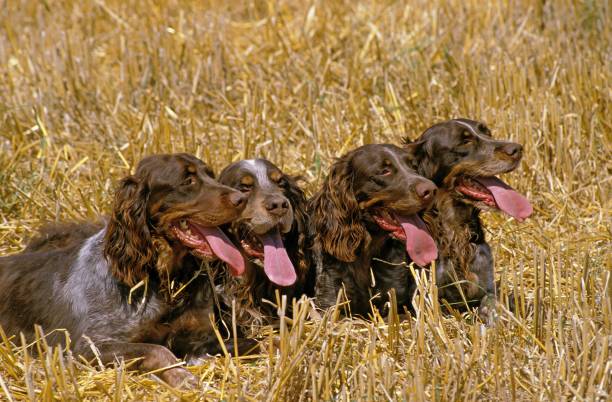Picardy Spaniel

Breed History:
The Picardy Spaniel (Épagneul Picard) is one of the oldest continental spaniel breeds, developed in the Picardy region of northern France during the Middle Ages. It was used by the French nobility for upland bird hunting in marshy, wooded terrains.
Closely related to the Blue Picardy Spaniel, the Picardy is believed to have descended from early French hunting dogs crossed with British sporting breeds, especially after British hunters brought Setters and Spaniels to France in the 19th century. While historically popular among local hunters, the breed remains rare outside France today.
|
Gender |
Height |
Weight |
|
Male |
55-60 cm |
20-25 kg |
|
Female |
55-60 cm |
18-23 kg |
Size: Medium
Life Expectancy: 12–14 years

Breed Appearance:
The Picardy Spaniel is a strong, well-built gun dog with a soft, intelligent expression. It has a broad head, long feathered ears, and dark amber eyes. The body is slightly longer than tall, with moderate bone and feathering on the legs and tail.
Its medium-length coat is wavy and dense, usually in mottled liver (brown roan) with occasional tan markings. This coat helps protect it from harsh weather and rough terrain.
Breed Type – Gun Dog (Versatile Hunting Breed):
The Picardy Spaniel is a calm, versatile hunting companion, bred for pointing, retrieving, and working in wetlands. It has a gentle mouth, a steady pace, and a keen nose for locating game.
Unlike some more high-strung sporting dogs, the Picardy is known for its even temperament, making it well-suited as a family pet as well as a working dog.

Training:
This breed is intelligent, cooperative, and eager to learn, making training generally easy:
-
Responds well to positive reinforcement
-
Has an instinct for hunting tasks
-
Requires early socialisation to ensure calm behaviour in new environments
-
Rarely stubborn, but thrives with consistent, gentle guidance
It enjoys structured work and benefits from scent-based challenges.
Health & Care:
The Picardy Spaniel is a hardy and healthy breed, but some issues may arise:
-
Ear infections due to long, drooping ears
-
Hip dysplasia (uncommon but worth screening)
-
Occasional eye conditions
-
Obesity if under-exercised
Routine care, a healthy diet, and regular checkups help maintain good health. Pay close attention to ear hygiene.

Living Conditions:
The Picardy Spaniel adapts well to country or suburban homes, especially those with access to open space. They are calm indoors if their physical and mental needs are met.
-
Best suited to active households
-
Does well with children and other dogs
-
Needs companionship—not ideal for long hours alone
-
Can live in larger apartments with ample daily exercise
Exercise:
Moderate to high activity needs:
-
At least 60 minutes of exercise daily
-
Enjoys hiking, retrieving, swimming, and nose work
-
Long walks, field games, and off-leash time (in secure areas) are ideal
-
Without exercise, one may become bored or restless
Their stamina and scenting ability make them excellent outdoor companions.
Grooming:
Moderate grooming needs:
-
Brush 2–3 times per week to remove tangles and reduce shedding
-
Clean ears regularly to prevent infections
-
Trim feathered areas if they collect debris
-
Bathe as needed—typically after outdoor activity
-
Maintain nail and dental care
The coat is weather-resistant and relatively easy to maintain for a field dog.

Advantages:
-
Calm and affectionate at home
-
Excellent all-around hunting dog
-
Gets along well with people, kids, and dogs
-
Low prey drive indoors—rarely destructive
-
Trainable and eager to please
-
Unique and noble-looking French breed
Disadvantages:
-
Needs regular exercise and stimulation
-
Not widely available outside France—can be hard to find
-
Prone to ear infections if not cleaned
-
May be reserved with strangers
-
Requires grooming attention to feathering
-
Doesn't thrive in highly urban or inactive homes

